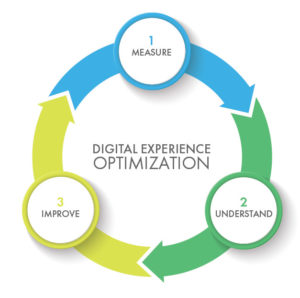
Is Digital Experience Worth More Than Conversions?
Digital excellence is about the experience.
Being a digital leader means shifting from a mindset of conversion rate optimization (CRO) to one of digital experience optimization (DXO). We’re not implying that conversions don’t matter but instead that a broader view is necessary. Growth-minded organizations must pay attention to each touchpoint between a customer and their brand—touchpoints that lead not only to the initial transaction but to an ongoing relationship.
In other words, the path to greater customer lifetime value (LTV) is a meaningful, actionable, and optimized journey.
Optimizing these experiences requires alignment among multiple channels and touchpoints. It also requires the right strategy, the right people, and the right technology. As complex and multifaceted as this may be, our Smart Panda Labs team left the Opticon 2018 conference feeling very clear on the three fundamental steps of DXO, all three of which are similarly fundamental to our own practice: 1) Measure, 2) Understand, and 3) Improve.

Measure
Good data is worth its weight in gold—and sometimes, more. But in order to capture the right data in a useful way, you need the right tools. Optimizely once partnered with other SaaS providers including Tealium, Salesforce, and FullStory to create a digital experience stack. The goal of this platform was not only to create a robust view of the customer at all points in their journey but to make that data meaningful and actionable. For example, Tealium can stitch together anonymous and known visitor data and then leverage those audiences within Optimizely to generate more consistent cross-device experiences. Time is also a key component of capturing data in a meaningful and actionable way, and the open DXS platform allows you to lay out and execute a strategy of real-time insights and actions.
Understand
It’s only when the data can drive insights, and those insights can lead to actions, that you can effectively meet business goals, such as improved LTV. Thus, once you have integrated your data, you must derive meaning from it. Digital leaders, including many of the brands represented at Opticon 18, are making experimentation part of their DNA, pushing the envelope to understand the “why” behind test results and not just accept results as they appear.
One particular conference session focused on steps to create advanced customer theories that are iterative and transferable—theories that attempt to explain why customers acted or responded in a certain way. A theory might be as simple as a preference for calls to action that are above the fold, for example. They might relate to a customers’ state of mind or persona. Or you might even consider broader factors, like behavioral economics or laws of reciprocity. Intended as a team activity, the brainstorming should include diverse stakeholders who can lend unique perspectives to the exercise. Hypothesizing why consumers acted a certain way is a great opportunity to step out of analytics mode and into an empathetic state of mind in an effort to identify theories that warrant further testing.
The real goal here? To find those theories most likely to hold value—and to build a case around them. Before upgrading a theory to a conclusion, try to garner at least five experiments that support it. Then, use these insights as the basis for other enhancements to the experience, from email communications to marketing messages to personalization campaigns.
Improve
All of your measurements, tests, and the understanding you’ve acquired as a result lead to the real opportunity: optimization. How can you leverage your findings to improve the customer experience at every touch point? How can you offer a more concierge-like experience, one that make suggestions based on their interests or offers information in a way that is in sync with their preferences? Are there reviews or ratings that can support and enhance their purchasing decisions?
When it comes to moving customers through the funnel, an enhanced experience is more likely to boost LTV than the speed of the transaction. Think a little less about what will drive the purchase today and little more about what will drive multiple purchases over the long term. Because a leading digital strategy is the one that takes the long view.
Throughout this conference, my colleagues and I felt a rewarding sense of resonance between what we heard coming from the stage and the work we’ve been doing for our clients. We left Opticon with even more frameworks and tools to help brands shift from a sharp focus on CRO to a bigger picture view that puts customers and customer experience at the center of their digital strategy.
Key Takeaways
- Being a digital leader means shifting from a mindset of conversion rate optimization (CRO) to one of digital experience optimization (DXO).
- The three fundamental steps of DXO are: 1) Measure, 2) Understand, and 3) Improve.
- In order to capture the right data in a useful way, you need the right tools. Optimizely once partnered with other SaaS providers including Tealium, Salesforce, and FullStory to create a digital experience stack.
- Make experimentation part of your DNA; push the envelope to understand the “why” behind test results and not just accept results as they appear.
- Ask yourself how you can leverage your findings to improve the customer experience at every touch point. How can you offer a more concierge-like experience, one that make suggestions based on their interests or offers information in a way that is in sync with their preferences?
- Think a little less about what will drive the purchase today and little more about what will drive multiple purchases over the long term. Because a leading digital strategy is the one that takes the long view.
READY TO PROVIDE A BETTER POST-CLICK EXPERIENCE?
Get insights and tips to drive more business from less ad spend, more profit from less cost, and more customer value from less churn.
